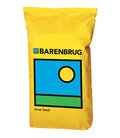'Wholesome' pastures bring herd health benefits
A more holistic approach to pasture management – specifically, species composition and soil health – can pay dividends for flock health, grazing utilisation and overall enterprise economics.

A more holistic approach to pasture management – specifically, species composition and soil health – can pay dividends for flock health, grazing utilisation and overall enterprise economics.
It’s easy to be ambivalent about UK grassland. We have a successful track record for good grass, thanks to a highly favourable climate. But to make good grassland into excellent grassland, we move beyond the usual concerns about productivity and dry matter content.
While Barenbrug’s primary focus is grass genetics – the varieties it’s developing and trialling now will provide the leys and silage cuts of the mid-2030s – the company also has an acute interest in ‘what makes a pasture a pasture’.
The best pastures feature not just a mixture of grass varieties, but also herbage and other broad-leaved plants that can convey considerable benefits to the flock or herd.
Many farmers are already aware of the important baseline benefits from a sward that contains more than the ‘default’: perennial rye-grass and white clover. It’s accepted that there’s a higher liveweight gain when compared to PRG and PRG/WC swards.
Lambs and cattle reach slaughter weight more quickly or can be sold fat instead of store. Quicker growth rates and sale make more efficient use of grass.
Greater emphasis on legumes in the sward can also achieve the same dry matter yield, ensuring less reliance on big-bag nitrogen.
But it’s not just the production benefits. A mixed sward makes for healthier stock, improving the quality of replacements for the flock or herd. Studies show a mixed sward’s ability to boost the animal’s immune system, resulting in fewer subclinical losses and reduced vet and med bills.
This phenomenon is largely attributed to a mixed sward’s ability to access more of the soil’s nutrients. Deep-rooting species – herbs such as plantain and chicory, and legumes like red clover – draw up valuable trace elements from lower soil profiles.
These would be otherwise inaccessible to the ‘usual’ PRG ley, allowing you to create a healthier, more nutritious ley. Those same deep roots also instil drought tolerance to a pasture – something that ‘early adopters’ have noticed during the summer past.
Deep-rooting herbs and legumes create a dense, complex root system, producing root exudates – carbohydrates from photosynthesis – that feed and build the soil microbiome, boosting soil organic carbon and improving soil fertility and structure.
These root-microbe interactions are often one of the first casualties of over-reliance on synthetic nitrogen fertilisers. It’s paradoxical that by cutting back on nitrogen application, you can help your pastures make more efficient use of existing soil nutrients.
Beef and sheep farmers will be familiar with many of the trace element deficiencies. Typically, subclinical losses include decreased daily liveweight gain or milk yield, increased parasitic burdens and lower immunity to other diseases, or reproductive issues such as lower conception rates and poor colostrum quality and yield.
More specific deficiencies are identified with copper, cobalt, selenium and zinc. Of course, even the best herbal ley can’t procure nutrients that aren’t present in a particular soil type. But it’s worth pointing out that in general, grass species tend to be commonly deficient in phosphorus, magnesium, copper and cobalt, while clovers tend to contain higher levels of these trace elements, and herbs higher still.
But it’s the anthelmintic characteristics of certain herbs that are of most interest. Anthelmintic resistance is a challenge. Nearly 40 years since identifying the first case, benzimidazole resistance is thought to affect 90 per cent of British sheep farms, and of the five wormer groups available to UK farmers, we have resistance to four.
Given growing evidence showing the damaging effect of chemical anthelmintics on invertebrate biodiversity, plus the practical difficulties and effects – animal stress, labour, time – of gathering and handling livestock for dosing, ‘cultural’ control looks particularly attractive.
Chicory is one of the leading herbal contenders. It’s been shown to result in reduced egg count and adult abomasal worm numbers in lambs, although the results are less evident in adult sheep and there appears to be no effect in cattle.
The jury’s still out on chicory’s mode of action but it’s thought the hairy stems could reduce parasitic movements and interrupt worm life cycles. It’s also possible that substances within chicory act directly on the parasites, or reduce their activity.
Other plants, including sainfoin and birds-foot trefoil, contain compounds – condensed tannins – known to be anti-parasitic, although these aren’t present in chicory. Chicory is high in protein and trace elements, so its anti-parasitic effect may simply make lambs healthier and more resistant.
Condensed tannins (CTs) decrease egg numbers, reduce hatching, impede larval development and inhibit larval mobility. Another benefit is improved feed protein utilisation, not only improving meat and milk yield but reducing the amount of nitrogen excreted in urine. CTs also impede methane-producing gut microbes, which can reduce methane production – another environmental benefit.
Given the multiple benefits of a mixed sward, it’s not surprising that some producers have nicknamed them ‘salad bars’. It’s healthy, wholesome eating for your flock or herd, in much the same way as we’re encouraged to go with our ‘five-a-day’ of fruit and veg.
The concept of the ‘wholesome pasture’ is one that Barenbrug will continue to investigate and support as part of our total commitment to helping farmers grow good grass.

A blend of chicory, plantain and covers designed specifically for grazing all classes of livestock.

Designed to extend the shoulders of the grazing season whilst enhancing the yield and the quality of the sward.

A multispecies legume, grass, and herb sward for increased biodiversity.

A bestselling mixture that is designed to be a persistent, drought tolerant, protein-rich sward for beef and sheep production.